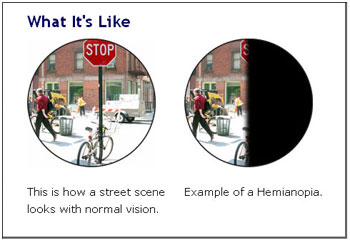06 Aug Visual Impairment & Occupational Therapy
Many people who are diagnosed with a neurological condition, such as a stroke, Parkinson’s Disease, or Multiple Sclerosis are vulnerable to changes in their vision called visual impairments. Visual impairment can vary from experiencing double vision to a loss in vision for the left or right side of the visual field. Loss of vision to the left or right side is called a Homonymous Hemianopsia and the resulting vision impairment with seeing things as typical as a plate or busy street.

Courtesy of lighthouseguild.org.
Homonymous Hemianopsia can lead to inattention also known as “neglect” to a person’s left or right side of their body and their world.
Vision plays a HUGE part in how we view and react to the world.
Our brains are constantly looking for visual patterns and when we think we see one we pay attention to learn more about it. Visual patterns can alert us to danger or pleasure (think of the pattern we see in a sunset), as well as enable us to anticipate and plan for dangerous situations, the rotation of clouds that lead to a tornado as an example. When there is a disruption in how one interprets visual feedback, it affects not only the ability to perform an array of daily tasks using the eyes, but also how one behaves.
People who experience double vision, a significant loss of vision or Homonymous Hemianopsia may exhibit behavioral changes including anxiety, slowed speed in processing and responding, decreased confidence to complete daily tasks, decreased attention, and increased passiveness when making decisions.
Daily tasks such as driving and reading are highly affected by visual impairments, but basic daily activities can also be affected. Limited vision affects the ability to see all the food on a plate, find and identify personal belongings in a closet or bathroom, and remain balanced when walking!
Occupational therapy can help!
Occupational therapists’ primary focus is independence and health. Typically, visual impairments are rarely restored so that is not the focus of occupational therapy program. Therefore, an occupational therapist works with patients to improve their ability to complete daily tasks with as much independence as possible despite vision loss. Successful therapy relies on the input from vision professionals such as an opthalmologists, specifically a neuro-opthalmologist and optometrists to determine the amount of visual loss a person has experienced.
An occupational therapist’s, with visual impairment experience, role is not to evaluate the amount of visual loss, as that has been determined by the eye specialists, but rather identify what daily living tasks are impaired and how to intervene to achieve an optimal outcome based on the patient’s overall daily living goals.
The role of an occupational therapist:
- A visual impairment-trained occupational therapist will address a person’s basic oculomotor capabilities or how well they move their eyes. If there is an obvious eye-movement issue, the therapist may recommend a follow-up appointment with their eye doctor or perform basic eye exercises to improve the ability for smoother movement of the eyes.
- For those experiencing visual impairment, the occupational therapist will focus their program on helping their patient safely move around their environment. If a person only has one half of their visual field, they’ll often ignore or neglect the side with vision loss.
- Occupational therapists will also use verbal cues, both from the therapist, as well as the client themselves, with exercises focused on turning their head towards the “blind side.” In addition, the therapist may place visually striking cues on the wall of the “blind side,” and then have the client perform basic tasks such as counting the number of striking visual cues on the wall as he or she walks down the hallway. As the client’s accuracy and speed improves, the occupational therapist may ask for a faster walking speed, adding cues to the “blind side” and non-blind side for a greater challenge. This in-clinic activity is then translated to real-life situations such as walking down a grocery aisle and pulling specific canned vegetables off the shelf.
- Finally, and by far one my favorite activities for those with visual challenges, is the rehabilitation process for improving reading abilities. There are so many reading options for clients today, including lighted magnifiers (often found at the library), large print books, and pre-reading strategies for those who have experienced a visual field cut. When a person can re-learn how to read, despite a visual field cut, it not only allows for that person to read for leisure again but also aids in following recipes, reading labels on pill bottles, and enjoying written letters from family and friends.
Throughout all visual retraining, an occupational therapist will address small changes that equal big results, including addressing issues with glare, contrast, lighting, and even organization. Some solutions are more difficult than others when it comes to improving independence, but an experienced occupational therapist will work hard to find the best solution for each client’s visual challenges. To learn more about how occupational therapy programs can help vision concerns, download AOTA’s OT’s Role Fact Sheet.
Trio Rehab’s talented occupational therapists are here to help!
The key to successful occupational therapy is early intervention. If you or someone you care for is experiencing a visual impairment, don’t wait. Give us a call today to make an appointment to see one of our talented and highly trained occupational therapists.

Jennica Colvin, Owner & Occupational Therapist
Trio Rehabilitation & Wellness Solutions
Boerne, Texas


